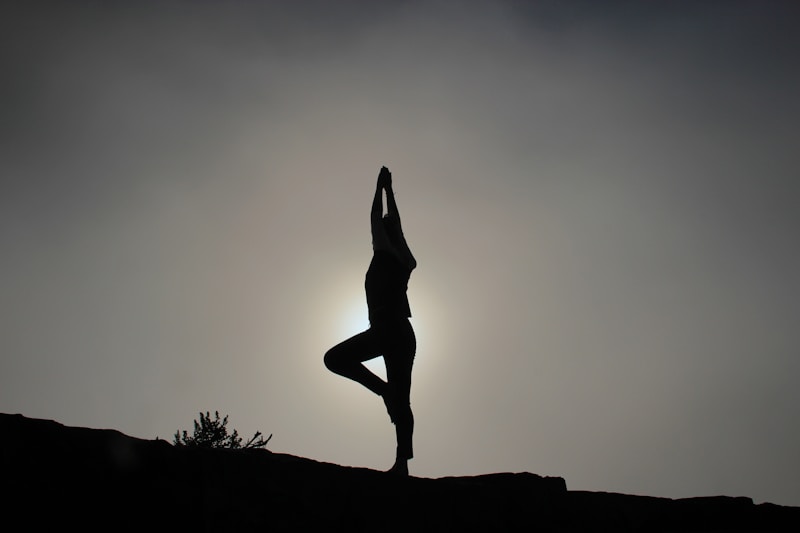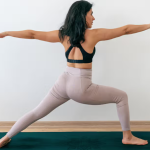Do you feel under pressure to turn up to your yoga class in the ‘right’ yoga gear? Do you hanker after a pair of ultra-cool, high-end leggings that you’ve seen modelled on Instagram? Or are you one of those students that stubbornly wear your leggings until they’re practically threadbare? Or, maybe, you’re somewhere in the middle, with a few leggings to choose from, but without a full-blown yoga gear addiction.
Whichever camp you fall into, the choice of yoga wear is proliferating at a bewildering speed. With this comes a huge choice of what to wear for your yoga practice, from a basic cotton pair from the local supermarket to a £170 pair of star-spangled Ultracor leggings. But what’s the truly yogic response to the sweet shop of yoga wear on offer?
The Rise and Rise of Yoga Gear
In the early 50s and 60s, when yoga first arrived on our shores, newly converted yoga acolytes wore gym shorts or jersey leotards. There was no such thing as ‘yoga gear’.
Now, fast forward half a century and the yoga gear business is booming; the global industry is now worth over £74 billion, annually. Big brands such as Lululemon and Sweaty Betty dominated the athleisure market for years, but now there are other boutique fitness brands, such as American-based Bandier, jostling into the forefront, which stock a range of high-end fitness brands.
Social media has played a big part in promoting yoga wear, with celebrities posting glossy images of yoga poses, while tagging their clothing brands. Followers who can’t emulate the pose can at least get the same leggings and feel a little bit closer to the yogi dream.
Making a Statement
What we wear is a statement about who we are, and our yoga wear is no different. Fashion follows the trends and as yoga becomes more and more popular (never a bad thing), the clothing industry has cottoned on and is feeding our desire to look the part.
Purchasing expensive leggings is a way of broadcasting to others what a luxury, yogic kind of lifestyle you have. It is also a statement of individuality. The cult of the individual is a Western phenomenon. We are told in countless aphorisms online to ‘be yourself’ and to be proud to express ourselves as individuals.
René Descartes, the French mathematician and the father of modern philosophy, put it succinctly when he wrote: ‘Self-expression is individuality, and our individuality is our self, which ought to be our chief concern’.
But should it? And what does yoga have to say on the matter?
What’s the Yogic view?
Before we even get to our yoga mats, there are two stages of yoga. The first and second stages of yoga are the ethical codes – the yamas and niyamas – which cast some light on our everyday conduct.
The yama, asteya, which means literally non-stealing, suggests that true followers of yoga should not desire to possess what another has, which casts a bit of doubt on the yogic-ness of scrolling through Instagram drooling over celebrity-endorsed leggings.
Then there’s aparigraha, meaning literally non-hoarding, or modest living. Aparigraha dictates that we choose not to live life to excess, rather choosing a balanced approach to our possessions. Perhaps we can apply this by taking a moment to pause before purchasing, and asking ourselves, ‘Do I really need this, or is it just to satisfy my desires of this moment?’
To conclude, in stark contrast to the individualist view of Descartes and the rest, Yoga literally means ‘union’. It is the union of mind and body, and the union of your individual self with the greater universal consciousness. The ultimate goal of yoga is samadhi – the last stage of the 8-step yoga programme to enlightenment – when the yogi reaches a state of bliss where there is no sense of ‘I’. Presumably, there’s no bar to gaining Samadhi if you’re not wearing the most up-to-date yoga clothes…
However…
There are provisos to the strict, ascetic ideals of the yamas and niyamas. Which is that we are only human. And we don’t live in an ashram in India, nor are we the original ascetic yogis who had no possessions AT ALL.
How can we not lust after the beautifully bright yoga leggings modelled by Kino as she ties herself into a figure of eight on the beach? Especially if we’re stuck in rainy old Blighty and our yoga class is the highlight of the week.
There is also the fact that we need to feel good about ourselves – which is harder to do when you’re sporting holes in the crotch of your leggings or a moth-eaten yoga top. If you’re finding it hard to concentrate on your yoga because you’re worried that the student behind you can see your knickers through your leggings, it’s probably time to invest in a new pair.
Plus, if you’re a yoga teacher, what you wear are your working clothes, and they need to work hard for you. As a yoga teacher myself, having spent many years making do with cheap leggings, I finally treated myself to three pairs of expensive leggings and I have to admit they were worth every single penny. They’re good quality and comfortable, while not being ostentatious enough to distract my students from watching my demonstrations.
An Afterthought – Ethical Yoga Wear
Perhaps there is a more yogic way to indulge our passion for yoga wear? It would be easy to assume that clothes promoted as yoga wear would have an ethical outlook. However, sadly, this is not always the case. Most big brand yoga leggings and equipment are made from man-made fibres that leech tiny micro-plastics into the environment every time they’re washed. However, there are a growing number of small, independent businesses that are working hard to make yoga clothes that are both better for the environment and the people who actually make them.
By buying fairtrade, environmentally-friendly yoga clothes we can follow the yama of ahimsa – non-violence – which might go some way to cancelling out our trasngression of the others.
At the end of the day, it’s a balance between choosing clothes that will wear well, are comfortable and do the job of helping you enjoy your practice. Because if buying a pair of high-end expensive leggings will guilt-trip you onto your mat every day, then maybe it’s just worth it.













